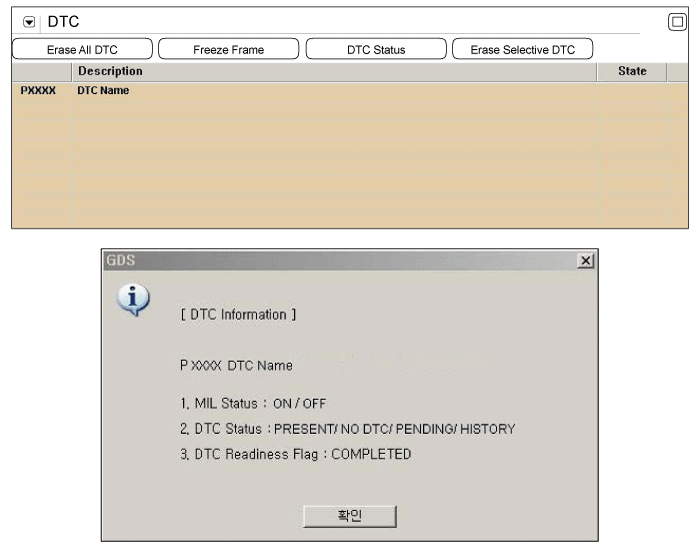
The Engine Coolant
Temperature Sensor (ECTS) is located in the engine coolant passage of the
cylinder head for detecting the engine coolant temperature. The ECTS uses
a thermistor whose resistance changes with the temperature. The electrical
resistance of the ECTS decreases as the temperature increases, and
increases as the temperature decreases. The reference 5 V in the PCM is
supplied to the ECTS via a resistor in the PCM. That is, the resistor in
the PCM and the thermistor in the ECTS are connected in series. When the
resistance value of the thermistor in the ECTS changes according to the
engine coolant temperature, the output voltage also changes. During cold
engine operation the PCM increases the fuel injection duration and
controls the ignition timing using the information of engine coolant
temperature to avoid engine stalling and improve drivability.
If the ECT signal is
stuck above the lowest enabling temperature value, P0116 is set.
MIL(Malfunction Indication Lamp) turns on when the malfunction lasts till
consecutive 2 driving cycle.
Item
|
Detecting
Condition
|
Possible cause
|
DTC
Strategy
|
| •
|
Monitor the engine coolant
temperature | |
|
Enable
Conditions
|
| •
|
Shutdown time > 180
minutes |
| •
|
Intake air-temperature at start-up <
40°C(104°F) |
| •
|
No disabling
faults(ECTS) |
| •
|
Engine running > 60
seconds |
| •
|
Minimum airflow is satisfied for a
certain time. | |
Threshold
value
|
| •
|
When the start-up engine coolant
temperature does not rise by 3
°C(5.4°F). | |
Diagnosis
Time
|
|
MIL On
Condition
|
|
Temp. (°C/°F)
|
Resistance (kΩ)
|
Temp. (°C/°F)
|
Resistance
(kΩ)
|
-40(-40)
|
48.14
|
40(104)
|
1.15
|
-20(-4)
|
14.13 ~
16.83
|
60(140)
|
0.59
|
0(32)
|
5.79
|
80(176)
|
0.32
|
20(68)
|
2.31 ~
2.59
|
|
|


The output signals of
IATS & ECTS change smoothly without any rapid changes. Those have
almost same characteristic signal during the early period after start. It
means that the temperatures of intake air and engine coolant are depended
on the temperature of atmosphere. Meanwhile, during the warming up, the
output signal of ECTS is going up increasingly. but, the output signal of
IATS changes a little bit. even it may not change almost. It means that
the heat of engine does not affect on the temperature of intake
air.
| 1. |
Check DTC Status
| (1) |
Connect scantool to Data Link
Connector(DLC). |
| (3) |
Select "DTC" button, and then Press "DTC
Status" to check DTC's information from the DTCs
menu. |
| (4) |
Read "DTC Status"
parameter.

|
| (5) |
Is parameter displayed "Present
fault"?
|

|
▶ Go
to "Component Inspection" procedure.
|
|

|
▶
Fault is intermittent, go to "Verification of vehicle
Repair"
procedure.
|
| |
■ Check ECTS Resistance
| 1. |
IG "OFF" and disconnect ECTS
connector. |
| 3. |
Measure resistance between signal and ground
terminals of ECTS connector as the temperature rises.
Specificaton :
Temp.
(°C/°F)
|
Resistance
(kΩ)
|
-40(-40)
|
48.14
|
-20(-4)
|
14.13
~ 16.83
|
0(32)
|
5.79
|
20(68)
|
2.31 ~
2.59
|
40(104)
|
1.15
|
60(140)
|
0.59
|
80(176)
|
0.32
|
|
| 4. |
Are the measured resistance within
specification?
|

|
▶ Clear DTC
and Test-drive under enable conditions above-mentioned. After
the test, If this DTC is set, recheck it thoroughly. If not,
it is intermittent fault, go to "Verification of vehicle
Repair" procedure.
|
|

|
▶
Substitute with a known - good ECTS and check for proper
operation.
▶ If the problem is
corrected, Go to "Verification of Vehicle
Repair"procedure.
|
|
| Verification Of Vehicle
Repair |
After a repair, it is
essential to verify that the fault has been corrected.
| 1. |
Connect scantool and select "DTC"
button. |
| 2. |
Press "DTC Status" button and confirm that
"DTC Readiness Flag" indicates "Completed". If not, drive the
vehicle within conditions noted in the freeze frame data or enable
conditions |
| 3. |
Read "DTC Status"
parameter |
| 4. |
Is parameter displayed "History(Not Present)
fault"?
|

|
▶ System
performing to specification at this time. Clear the
DTC.
|
|

|
▶ Go to the
applicable troubleshooting
procedure.
|
|